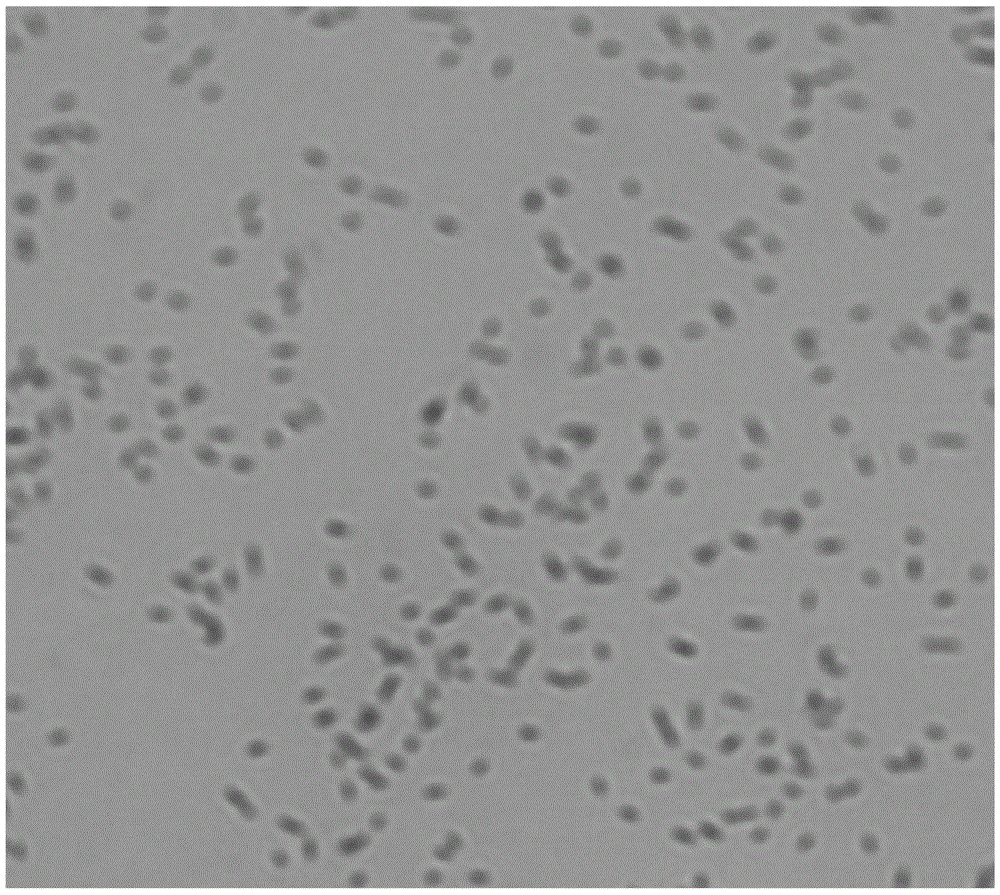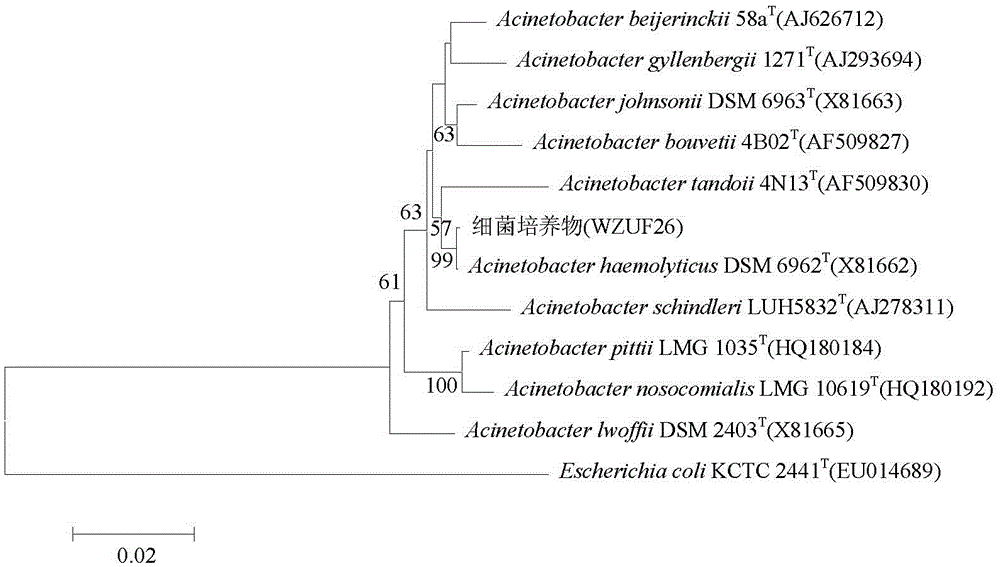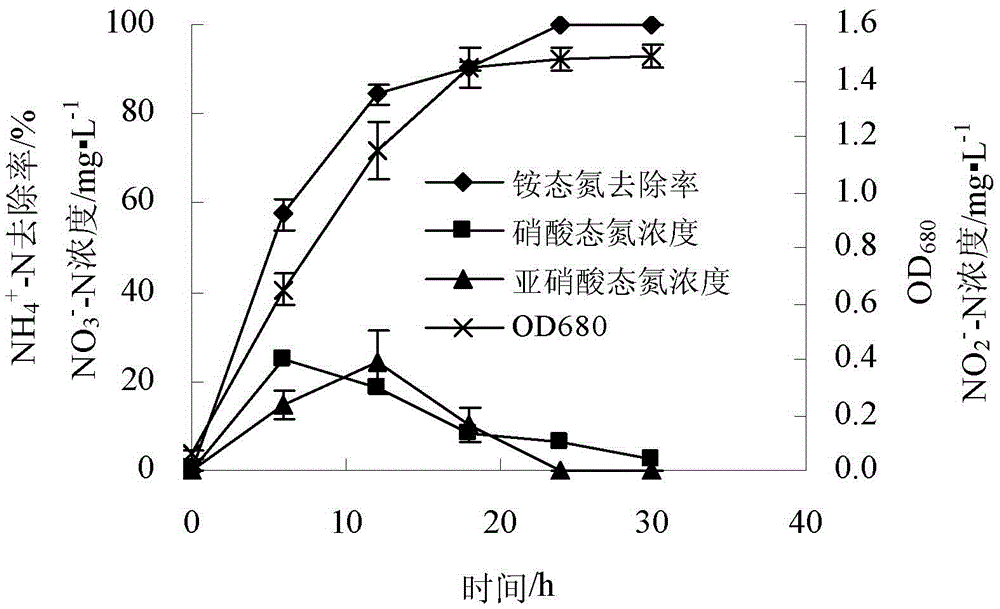Acinetobacter and application of acinetobacter in removal of nitrogen and phosphorus from wastewater
A technology of Acinetobacter, nitrogen and phosphorus, applied in the field of environmental microorganisms, can solve the problems of low SND efficiency, difficulty in achieving high removal efficiency of N and P, etc., and achieve the effect of high removal rate, wide temperature range and great application potential
- Summary
- Abstract
- Description
- Claims
- Application Information
AI Technical Summary
Problems solved by technology
Method used
Image
Examples
Embodiment 1
[0041] Example 1: Isolation and identification of heterotrophic nitrifying-aerobic denitrifying phosphorus accumulating bacteria
[0042] The sample is activated sludge taken from Wenzhou Xipian Sewage Treatment Plant. A certain amount of activated sludge was inoculated into the enrichment medium ((NH 4 ) 2 SO 4 1g, sodium citrate 5g, K 2 HPO 4 0.5g, MgSO 4 ·7H 2 O0.10g, CaCl 2 2H 2 O0.10g, FeSO 4 0.02g, nutrient solution 1mL, H 2 O1000mL, 1mol / L NaOH aqueous solution and / or 1mol / L HCl to adjust the pH to 7.0; the nutrient solution is an aqueous solution (g / L) containing the following concentration components: EDTA0.35, ZnSO 4 ·7H 2 O0.20, CuSO 4 ·5H 2 O0.10, MnSO 4 ·7H 2 O0.20, Co(NO 3 ) 2 ·6H 2 O0.09, H 3 BO 3 0.10, Na 2 MoO 4 0.10) Carry out enrichment culture at 25°C and 150r / min for 2 to 3 days, and then transfer to a new enrichment medium to continue enrichment culture after bacteria grow, repeating this 4 to 5 times. Then spread the appropriately d...
Embodiment 2
[0056] Example 2: Nitrogen removal characteristics of Acinetobacter WZUF26 with heterotrophic nitrification-aerobic denitrification and phosphorus accumulation
[0057] Inoculate the preserved strain (1.5mL frozen tube thawed bacteria solution) into a 500mL Erlenmeyer flask filled with 100mL activation medium (the formula is the same as that of enrichment medium in Example 1), and incubate at 30°C, 150~160r / min for 24h , centrifuged at 5000r / min for 10min, washed twice with sterile water, and then prepared with sterile water to prepare a bacterial suspension (OD 680 =0.900~1.000); then transfer to 100mL artificial NH at a volume ratio of 5% 4 + -N sewage or artificial NO 3 - -N sewage or artificial NO 2 - -N sewage in a 250mL Erlenmeyer flask, cultivated at a certain temperature and rotating speed for 48h, then centrifuged at 5000r / min for 10min to obtain a supernatant, and carried out relevant determination and analysis on the supernatant.
[0058] The present invention...
Embodiment 3
[0102] Embodiment three: process of removing nitrogen from artificial nitrogen sewage by Acinetobacter WZUF26
[0103] Acinetobacter WZUF26 bacterium suspension is obtained according to the embodiment two method, transfers to be equipped with 200mL artificial NH by 5% volume ratio 4 + -N sewage ((NH 4 ) 2 SO 4 0.94g, sodium citrate dihydrate 8.17g, K 2 HPO 4 0.5g, MgSO 4 ·7H 2 O0.10g, CaCl 2 2H 2 O0.10g, FeSO 4 0.02g, nutrient solution 1mL, H 2 O1000mL, 1mol / L NaOH aqueous solution and / or 1mol / L HCl to adjust the pH to 7.0; the nutrient solution is an aqueous solution (g / L) containing the following concentration components: EDTA0.35, ZnSO 4 ·7H 2 O0.20, CuSO 4 ·5H 2 O0.10, MnSO 4 ·7H 2 O0.20, Co(NO 3 ) 2 ·6H 2 O0.09, H 3 BO 3 0.10, Na 2 MoO 4 0.10), artificial NO 3 - -N sewage ((KNO 3 0.72g, sodium citrate dihydrate 4.08g, K 2 HPO 4 0.5g, MgSO 4 ·7H 2 O0.10g, CaCl 2 2H 2 O0.10g, FeSO 4 0.02g, nutrient solution 1mL, H 2 O1000mL, 1mol / L NaOH aqu...
PUM
 Login to View More
Login to View More Abstract
Description
Claims
Application Information
 Login to View More
Login to View More - R&D
- Intellectual Property
- Life Sciences
- Materials
- Tech Scout
- Unparalleled Data Quality
- Higher Quality Content
- 60% Fewer Hallucinations
Browse by: Latest US Patents, China's latest patents, Technical Efficacy Thesaurus, Application Domain, Technology Topic, Popular Technical Reports.
© 2025 PatSnap. All rights reserved.Legal|Privacy policy|Modern Slavery Act Transparency Statement|Sitemap|About US| Contact US: help@patsnap.com



